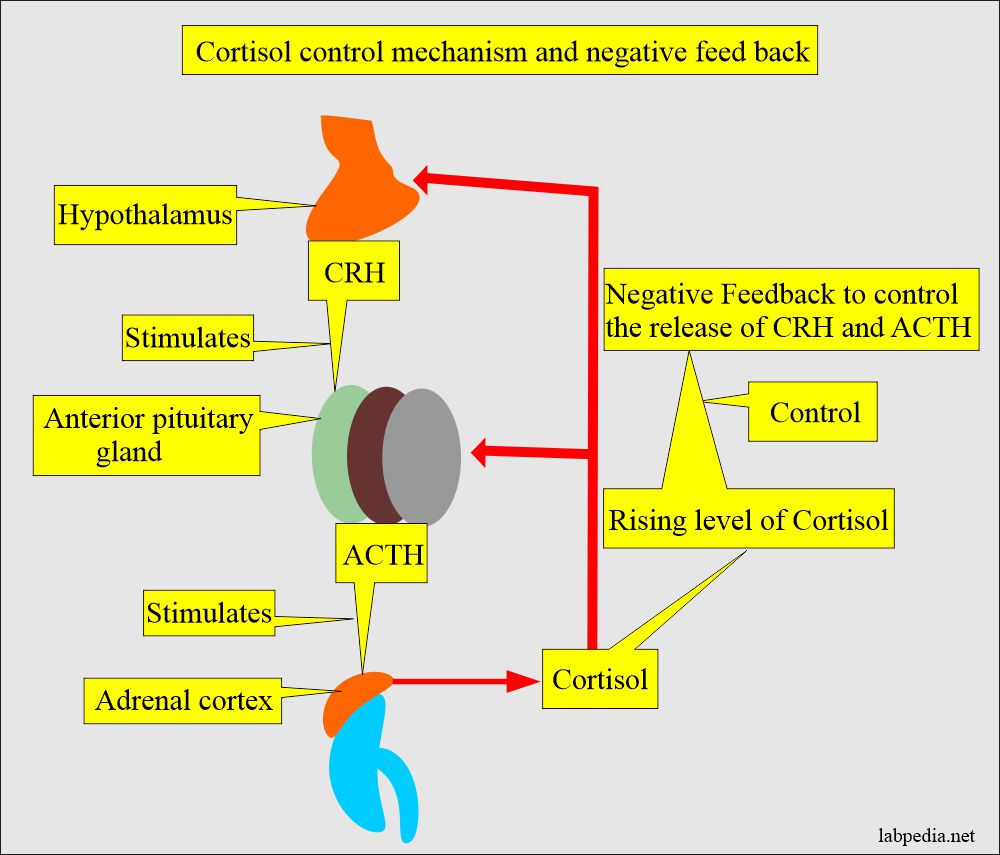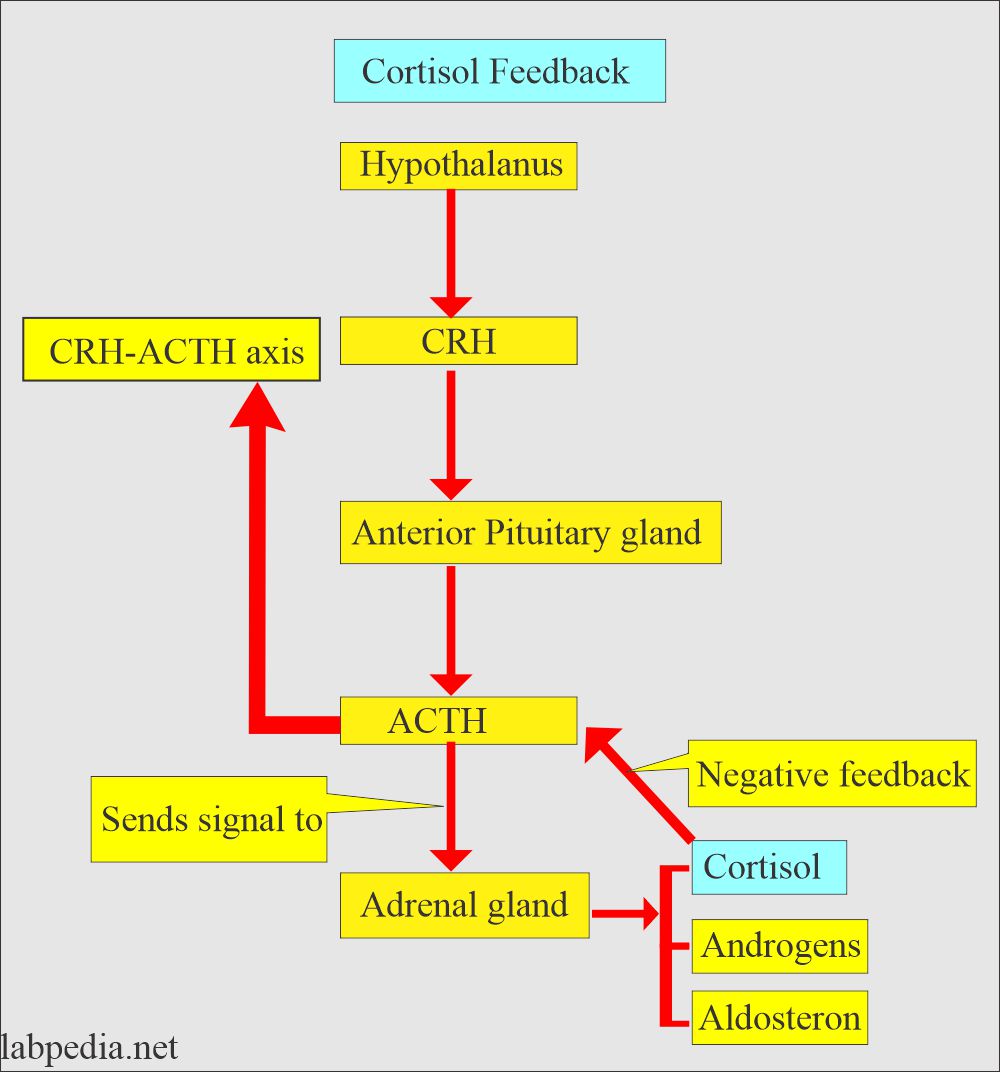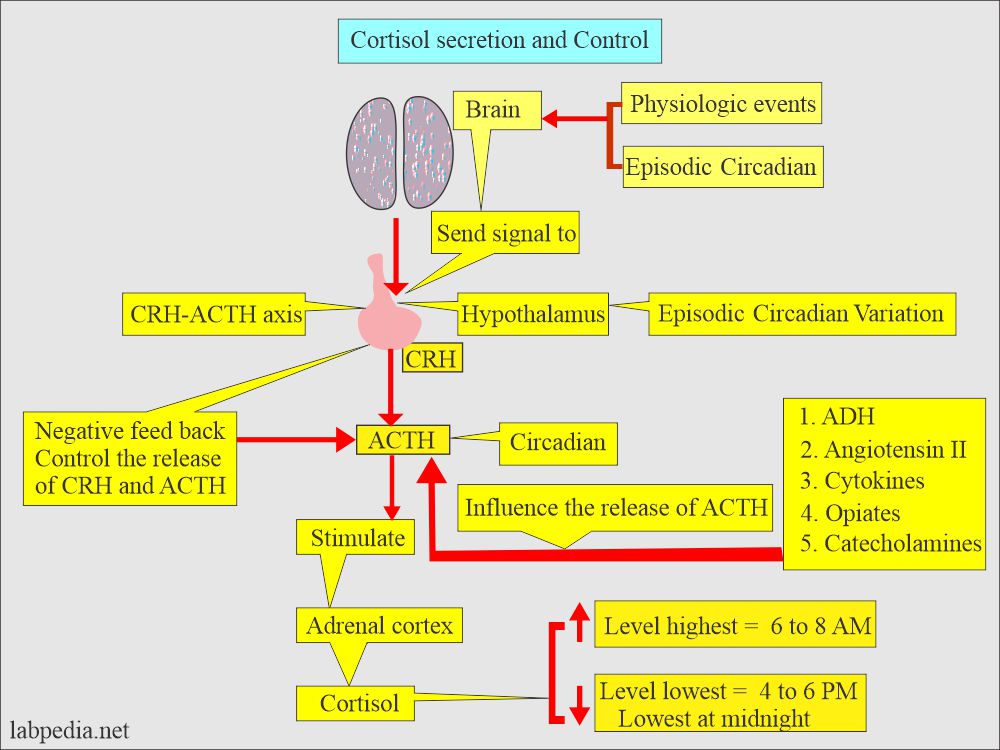Cortisol Suppression Test (Dexamethasone Suppression) (ACTH suppression)
Cortisol Suppression Test
Sample for a cortisol suppression test:
- Take fasting blood to prepare the serum.
- 24-hours urine sample. Take baseline 24-hour urine collection for corticosteroids (urine 17-OHCS) or urinary cortisol.
Rapid cortisol suppression test:
- This test is easy and quick to perform.
- This is used as a screening test for Cushing’s syndrome.
- Obtain 4 ml of fasting blood at 8 AM.
- Inject I/M or I/V cortisone.
- Collect blood 5 ml after 30 and 60 minutes of injection.
- Serum or heparinized blood can be used.
- What is the normal value of rapid cortisol suppression test = Nearly 0 cortisol levels.
Prolonged suppression test:
- Obtain 24 hours of urine as a baseline sample.
- Collect blood for baseline cortisol level.
- Collect 24-hour urine samples daily for 6 days.
- On day 3, give a low dose of dexamethasone by mouth (with antacid or milk).
- On day 5, give a high dose of dexamethasone by mouth like above.
- Keep the urine refrigerated.
- What is the normal value of a prolonged cortisol suppression test:
- Low dose = >50% reduction of plasma cortisol and 17-hydroxycorticosteroid levels (17-OCHS).
- High dose = 50% reduction of plasma cortisol and 17-OCHS.
Protocol for an overnight low-dose dexamethasone suppression test:
- One mg of dexamethasone is given at night at 11 PM by mouth.
- Collect the blood at 8 AM.
- A normal person’s cortisol concentration is suppressed to 2 µg/dL or less.
- Cushing’s patient does not show suppression, and the level may be >10 µg/dL.
Purpose of the test (Indications) for cortisol suppression test:
- This test is done to diagnose adrenal hyperfunction (Cushing’s Syndrome).
- This also diagnoses adrenal hypofunction (Addison’s disease).
Precautions for cortisol suppression test:
- Physical and emotional stress can increase ACTH release and interfere with the interpretation of the test result.
- Drugs that will interfere with the results are barbiturates, oral contraceptives, estrogen, Dilantin, steroids, and tetracyclines.
- Explain the procedure to the patients.
- Take the patient weight as a baseline for evaluation of side effects of steroids.
Pathophysiology of Cortisol hormone
- Corticotropin-releasing hormone (CRH) is made in the hypothalamus.
- CRH stimulates the production of ACTH from the anterior pituitary gland.
- ACTH stimulates the adrenal gland cortex (zona fscicultra) to produce cortisol.
- The feedback mechanism is rising levels of negative cortisol feedback, stopping the further production of CRH and ACTH.
- Cortisol is a potent glucocorticoid released from the adrenal cortex (zona fasciculta)
- Cortisol hormone affects the metabolism of:
- Carbohydrates.
- Proteins.
- Fats.
- The main effect is on the glucose level.
Cushing’s syndrome:
- Cushing’s syndrome is due to bilateral adrenal hyperplasia.
- The pituitary gland only responds to the high level of cortisol (corticosteroids).
- Cushing’s syndrome due to adrenal adenoma or cancer, cortisol secretion continues despite a decrease in ACTH.
- Cushing’s syndrome due to ectopic ACTH-producing tumors, there is the secretion of ACTH despite high cortisol levels.
Interpretations of cortisol suppression test:
- Suppression occurs in patients with:
- Cushing’s syndrome where the level is >10 µg/dL.
- In 50% of the cases, the cause is endogenous.
- There is no suppression in patients with:
- Adrenal Adenoma.
- Adrenal carcinoma.
- In the case of ectopic ACTH-producing neoplasm.
Table showing the relation of Cushing’s syndrome with the dose of cortisone:
| Disease | Causative reason | low dose | High Dose |
|---|---|---|---|
| Cushing’s syndrome | Bilat. adrenal hyperplasia | No change | >50 % reduction in cortisol |
| Cushing’s syndrome | Adrenal adenoma or carcinoma | No change | No change |
| Cushing’s syndrome | Ectopic ACTH tumors | No change | No change |
- Absent or failure response to cortisol stimulation seen in:
- Addison’s disease (adrenal insufficiency).
- Hypopituitarism (secondary adrenal insufficiency).
- Adrenal adenoma and carcinoma.
- Respond to cortisol stimulation indicate adrenal hyperplasia (Cushing’s syndrome).
Adrenal hyperfunction is seen in the following conditions:
- Cushing’s Syndrome.
- Ectopic ACTH- producing tumors
- Adrenal adenoma or carcinoma.
- Bilateral adrenal hyperplasia.
- Mental depression.
Adrenal Hypofunction is seen in:
- Addison’s disease.
- Neoplastic infiltration.
- Granulomatous inflammation like TB, histoplasmosis, and sarcoidosis.
- After adrenalectomy.
Differential diagnosis of adrenal gland tumors:
| Test | Normal | Cushing’s Syndrome | Adrenal tumor | Ectopic ACTH |
|---|---|---|---|---|
| Urinary free cortisol | <100 µg/day | >120 µg/day | >120 µg/day | >120µg/day |
| Serum cortisol | <3 µg/dL | >10 µg/dL | >10 µg/dL | >120 µg/dL |
| H.D Dexamethasone | 50% supp. | Most supp. | Fail to supp. | fail to supp |
Supp = suppression.
H.D = high dose.
Questions and answers:
Question 1: What is the significance of cortisol suppression test?
Question 2: In what cases there is no suppression of cortisol?



